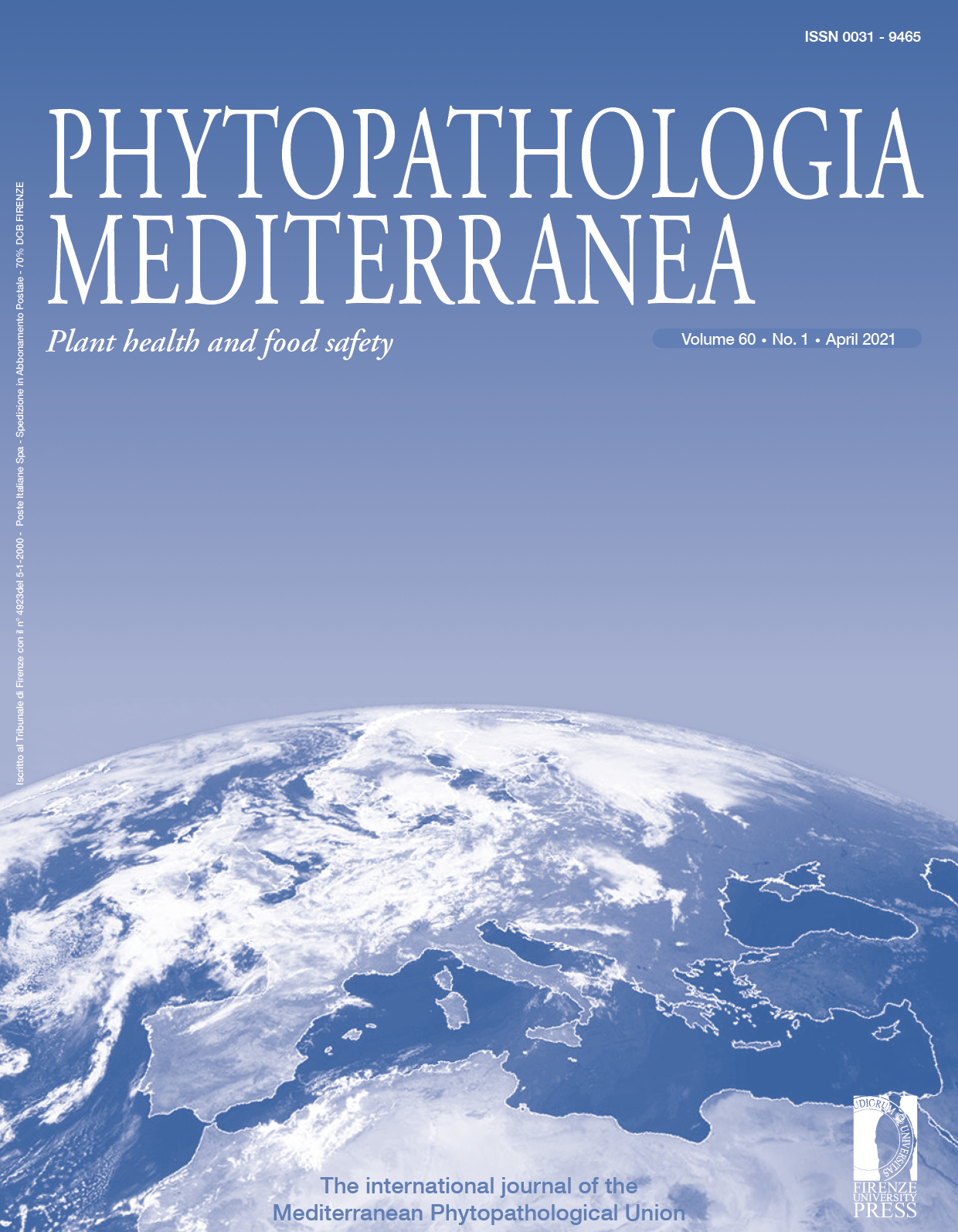First report of blast of durum wheat in Bangladesh, caused by Magnaporthe oryzae pathotype Triticum
Published 2021-05-13
Keywords
- Isolation,
- morphological detection,
- molecular analysis,
- pathogenicity
How to Cite
Abstract
Durum wheat (Triticum turgidum var. durum Desf.) is an important cereal crop in many regions of the world. In March of 2018 and 2019, symptoms typical of blast were frequently observed on durum wheat plants under field conditions in Jashore, Bangladesh. The putative causal pathogen was isolated from infected wheat spike specimens onto potato dextrose agar and oatmeal agar, and was identified from mono-conidium cultures as Magnaporthe oryzae, based on morphological features. The pathotype of the fungus was identified as Triticum, based on comparative molecular analyses of ITS sequences and MoT3 specific markers. BLAST analysis revealed >99.8% similarity with M. oryzae/P. oryzae, retrieved from the NCBI Genebank. This was confirmed through amplification of the predicted products with MoT3 primers in PCR analysis. Pathogenicity was confirmed by inoculating healthy durum wheat seedling leaves and spikes with a conidium suspensions of M. oryzae isolate DuBWMRI1901.2A. The fungus produced similar symptoms on inoculated leaves and spikes as those observed in the field, and was subsequently re-isolated, fulfilling Koch’s postulates. This is the first report of blast of durum wheat caused by Magnaporthe oryzae pathotype Triticum in Bangladesh.
Downloads
References
Cohen J., 1994. Fulfilling Koch's postulates. Science 266:1647.
Couch B., Fudal I., Lebrun M., Tharreau D., Valent B., ... Kohn L., 2005. Origins of host-specific populations of the blast pathogen Magnaporthe oryzae in crop domestication with subsequent expansion of pandemic clones on rice and weeds of rice. Genetics 170:613-630.
Igarashi S., Utiamada C.M., Igarashi L.C., Kazuma A.H., Lopes R.S., 1986. Ocurrence of Pyrcularia sp. in wheat (Triticum aestivum L.) in the State of Parana, Brazil. Fitopatologia Brasileira 11:351-52.
Kabbaj H., Sall A.T., Al-Abdallat A., Geleta M., Amri A., ... Bassi F.M., 2017. Genetic diversity within a global panel of durum wheat (Triticum durum) landraces and modern germplasm reveals the history of alleles exchange. Frontiers in Plant Science 8:1277.
Kato H., Yamamoto M., Yamaguchi-Ozaki T., Kadouchi H., Iwamoto Y., ... Naoki M.O.R.I., 2000. Pathogenicity, mating ability and DNA restriction fragment length polymorphisms of Pyricularia populations isolated from Gramineae, Bambusideae and Zingiberaceae plants. Journal of General Plant Pathology 66: 30-47.
Kumar S., Stecher G., Li M., Knyaz C., Tamura K., 2018. MEGA X: Molecular evolutionary genetics analysis across computing platforms. Molecular Biology and Evolution 35(6): 1547-1549.
Malaker P.K., Barma N.C.D., Tiwari T.P., Collis W.J., Duveiller. E., ... Valent B., 2016. First report of wheat blast caused by Magnaporthe oryzae pathotype triticum in Bangladesh. Plant Disease 100(11):2330.
NDWC, 2020. World Durum Production. (Source: International Grains Commission Xldata/world/all wheat/wheat/prod). Available at: https://www.ndwheat.com/uploads/6/world-web-charts
Ou S.H., 1985. Blast. In Rice Diseases, ed. SH Ou, Wallingford, UK: CABI, p. 109-201.
Pieck M.L., Ruck A., Farman M.L., Peterson G.L., Stack J.P., ... Pedley K.F., 2017. Genomics based marker discovery and diagnostic assay development for wheat blast. Plant Disease 101:103-109.
Sall A.T., Chiari T., Legesse W., Seid-Ahmed K., Ortiz R., ... Bassi F.M., 2019. Durum Wheat (Triticum durum Desf.): origin, cultivation, and potential expansion in Sub-Saharan Africa. Agronomy 9:263.
Subramanian C.V., 1968. Pyricularia oryzae. CMI Descriptions of Pathogenic Fungi and Bacteria.
Sundaram N.V., Palmer L.T., Nagarajan K., Prescott J.M., 1972. Disease survey of sorghum and millet in India. Plant Disease 56:740-743.
Urashima A.S., Igarashi S., Kato H., 1993. Host range, mating type and fertility of Pyricularia grisea from wheat in Brazil. Plant Disease 77:1211-1216.
Urashima A.S., Lavorent N.A., Goulart A.C.P., Mehta Y.R., 2004. Resistance spectra of wheat cultivars and virulence diversity of Magnaporthe grisea isolates in Brazil. Fitopatologia Brasileira 29:511.
White T.J., Bruns T., Lee S., Taylor J., 1990. Amplification and direct sequencing of fungal ribosomal RNA genes for phylogenetics. A Guide to Methods and Applications. Academic Press, San Diego, p.315-322.
Yahyaoui A., Hakim S., Al-Naimi M., Nachit M.M., 2000. Multiple disease resistance in durum wheat (Triticum turgidum L. var. durum). In: Royo C. (ed.), Nachit M. (ed.), D Fonzo N. (ed.), Araus J. L. (ed.). Durum wheat improvement in the Mediterranean region: New challenges. Zaragoza: CIHEAM p. 387-392 (Options Mediterraneennes: Serie A. Seminaires Mediterraneens; n. 40).






